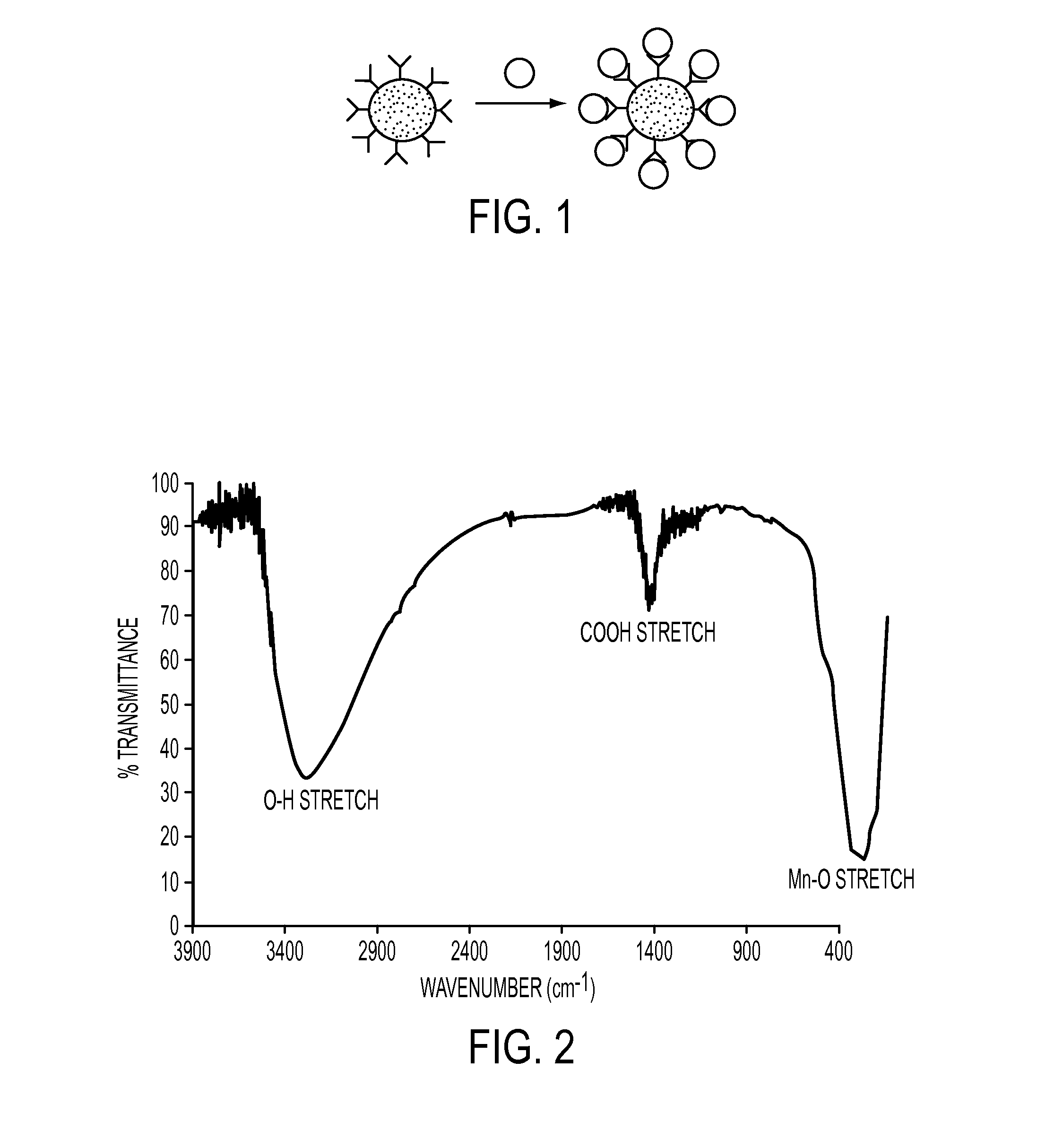Manganese-Oxo Clusters as Contrast Agents for Magnetic Resonance Imaging
a technology of magnetic resonance imaging and manganese oxo, which is applied in the field of contrast agents, can solve the problems of limited development of mn contrast agents, sensitivity limitation of mri, and toxicity of free mn metal, and achieves only limited effect on tsub>, and mn-dpdp has only been approved for imaging of the liver
- Summary
- Abstract
- Description
- Claims
- Application Information
AI Technical Summary
Benefits of technology
Problems solved by technology
Method used
Image
Examples
example 1
Mn-12 Clusters
Materials and Methods
[0070]4-vinylbenzoic acid (97%), Divinylbenzene (80%), Dichloromethane (anhydrous, 99%), Heptane (anhydrous, 99%), Ethanol (anhydrous, 99%, Toluene (reagent grade), Tetrahydrofuran (anhydrous, 99%), 2,2′-Azobis(2-methylpropionitrile) (98%) and styrene were purchased from Sigma-Aldrich (St. Louis, Mo.). Sodium Dodecyl Sulfate was purchased from Fluka (Seelze, Germany). Hexadecane was purchased from Alfa Aesar (Ward Hills, Mass.). Hydrochloric acid (37%, ACS grade) was purchased from EMD Chemicals (San Diego, Calif.). Polybead® Carboxylate Microspheres (2.73% Solids-Late) were purchased from Polysciences, Inc. (Warrington, Pa.) and separated from water by centrifugation at 4000 RPM for 10 minutes and were allowed to dry overnight. Mn12O12(O2CCH3)164H2O was synthesized in our lab according to the literature. (T. L is, Acta Crystallogr. Sect. B, 1980, 36, 2042).
Fourier Transform Infrared Spectroscopy (FTIR) Characterization
[0071]FTIR experiments were r...
example 2
Mn—Fe-oxo Clusters
General Information
[0096]All chemicals and solvents were obtained from Sigma-Aldrich and used as received. Infrared spectra were measured in the range 450-4000 cm−1 as pressed KBr pellets on a Nicolet 380 FTIR spectrometer. Elemental analysis was performed on a Perkin Elmer 2400 Elemental Analyzer, using acetanilide as standard. X-ray powder diffraction patterns were obtained using a Rigaku RAPID Curved IP X-ray powder diffiactometer with Cu Kα radiation and an image plate detector.
Synthesis of Mn8Fe4
[0097][Mn8Fe4O12(O2CCH3)16(H2O)4].4H2O.2CH3COOH, denoted here as Mn8Fe4, was prepared as described in previous reports (A. R. Schake, et al., Inorg Chem., 1994, 33, 6020-6028.; A R Schake, et al., J. Chem. Soc. Chem. Commun., 1992, 181-183.) Just briefly, KMnO4 (6.4 mmol) was added to a slurry of Fe(O2CCH3)2 (16.3 mmol) in 40 mL 60% (v / v) acetic acid / H2O and slowly heated to 60° C. The resulting reddish-brown solution was subsequently cooled to room temperature, layer...
PUM
| Property | Measurement | Unit |
|---|---|---|
| Temperature | aaaaa | aaaaa |
| Frequency | aaaaa | aaaaa |
| Frequency | aaaaa | aaaaa |
Abstract
Description
Claims
Application Information
 Login to View More
Login to View More - R&D
- Intellectual Property
- Life Sciences
- Materials
- Tech Scout
- Unparalleled Data Quality
- Higher Quality Content
- 60% Fewer Hallucinations
Browse by: Latest US Patents, China's latest patents, Technical Efficacy Thesaurus, Application Domain, Technology Topic, Popular Technical Reports.
© 2025 PatSnap. All rights reserved.Legal|Privacy policy|Modern Slavery Act Transparency Statement|Sitemap|About US| Contact US: help@patsnap.com



